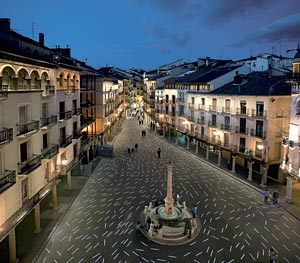Teruel, Spain
b720 Arquitectos
Tucked away in a sleepy corner of northeast Spain, the town of Teruel has long been a tourist destination for buffs of medieval architecture and history. Peppered with 12th-century bell towers distinguished by Mudéjar-style brickwork, Teruel earned a World Heritage site designation in 1986. Even so, the municipality is more interested in charting new architectural traditions than embalming its past. In 2003, for example, David Chipperfield and Barcelona’s b720 Arquitectos won a competition to design a passageway through an ancient stone wall separating the train station from a picturesque promenade, and the progressive results—all Cor-Ten steel and severe lines—garnered industry awards as well as a place in the 2006 exhibition On-Site: New Architecture in Spain at the Museum of Modern Art in New York. “The project transformed that part of town,” explains Fermín Vázquez, principal of b720 Arquitectos. “It also exposed the local government to the potential of Modernism to accentuate the historic fabric and to be an asset in its own right.”
So a few years later, when planning to rehabilitate Plaza del Torico, an elegant square in the heart of the historic district, the city asked Vázquez to propose a plan that would modernize the paving and lighting systems as well as the overall aesthetic. “Just removing the old systems and updating the pavers would have been a good solution, because the square is so picturesque. But to their credit, the clients were insistent about adding a contemporary intervention,” he says.
Vázquez’s design differentiates itself from the age-old charm of the existing square and engages the Art Nouveau facades that appear periodically within the streetscapes. Embedded in the 1¼2-acre triangular plaza around the square’s central stone fountain, it is a dynamic installation comprising 1,230 LEDs. Although illuminated only at night, the lights’ glass casings catch sunlight during the day, creating a mysterious sparkle underfoot. Arrayed in a scattering of diagonal lines, the luminaires nod to the plaza’s past—to a pair of medieval cisterns buried below granite pavers. The lights run in parallel lines above the domed cisterns, telegraphing the presence of the ancient rain-collecting structures, but elsewhere meander like water flowing around an obstacle. “The graphic patterning expresses what’s below,” says Vázquez. “Although modern, the design is quite meaningful to the town’s history.”
b720 partnered with lighting consultant Artec3 to resolve many of the technical details, including how the pavers should be lit. Vázquez explains, “First we considered luminescents, which accumulate light during the day and glow at night, but they fade too quickly. We also debated reflective surfaces, but the client wanted a stronger effect.” LEDs offered reduced maintenance and energy costs with the flexibility to manipulate the light’s intensity and hue (since the lamps are connected by underground wire to a central computer). “The plaza works like a screen,” says Vázquez. “In principle, you can design any effect you want, and change it often. But we established just a few set schemes apart from white light”—a strategy, he jokes, to keep the mayor from changing colors to celebrate every holiday or local soccer team victory.
The architects hoped to design a modular system of fixtures that would be combined to embed strips of illumination at a variety of lengths in the paving, but manufacturing proved too complicated. They settled for prefabricated luminaires 18 and 30 inches in length that are recessed in basaltic granite pavers and covered with tempered glass. The glass was subject to rigorous testing to ensure durability and watertightness, and the design team analyzed a variety of stones for their ability to withstand extreme temperature swings before settling on the granite.
The designers also used LEDs to illuminate the plaza’s facades, whose styles range from Baroque to Art Nouveau. The key to accentuating their elegance was, counterintuitively, to hit the dimmers. “Many old towns overlight historic structures,” notes Vázquez. Here, multiple headers on each building illuminate in the same direction from top to bottom, washing facades in an even glow. Covered porticos ringing the plaza required a similarly light touch: A streamlined dropped ceiling with a soft band of recessed lighting now traces the plane’s outer edge where there had been a cacophony of jostling wires and outdated fixtures.
Underground, a 4,410-square-foot network of white-walled corridors now connects the two cisterns, offering gallery space for exhibitions as well as enhanced tourist facilities. Paved in Villalva stone, the subtle scheme highlights the cisterns’ simple, unpretentious beauty with walls that peel away to expose the old brickwork, and a ribbon of LEDs snaking along the floor. “It’s a very clean design,” Vázquez concludes. “The archaeological interest wasn’t tremendous, and we didn’t want to upstage it with bold architecture.” Although b720 leaves a contemporary mark on this space, the deferential design, like its work above ground, shines the spotlight on its predecessor rather than itself.


Post a comment to this article
Report Abusive Comment